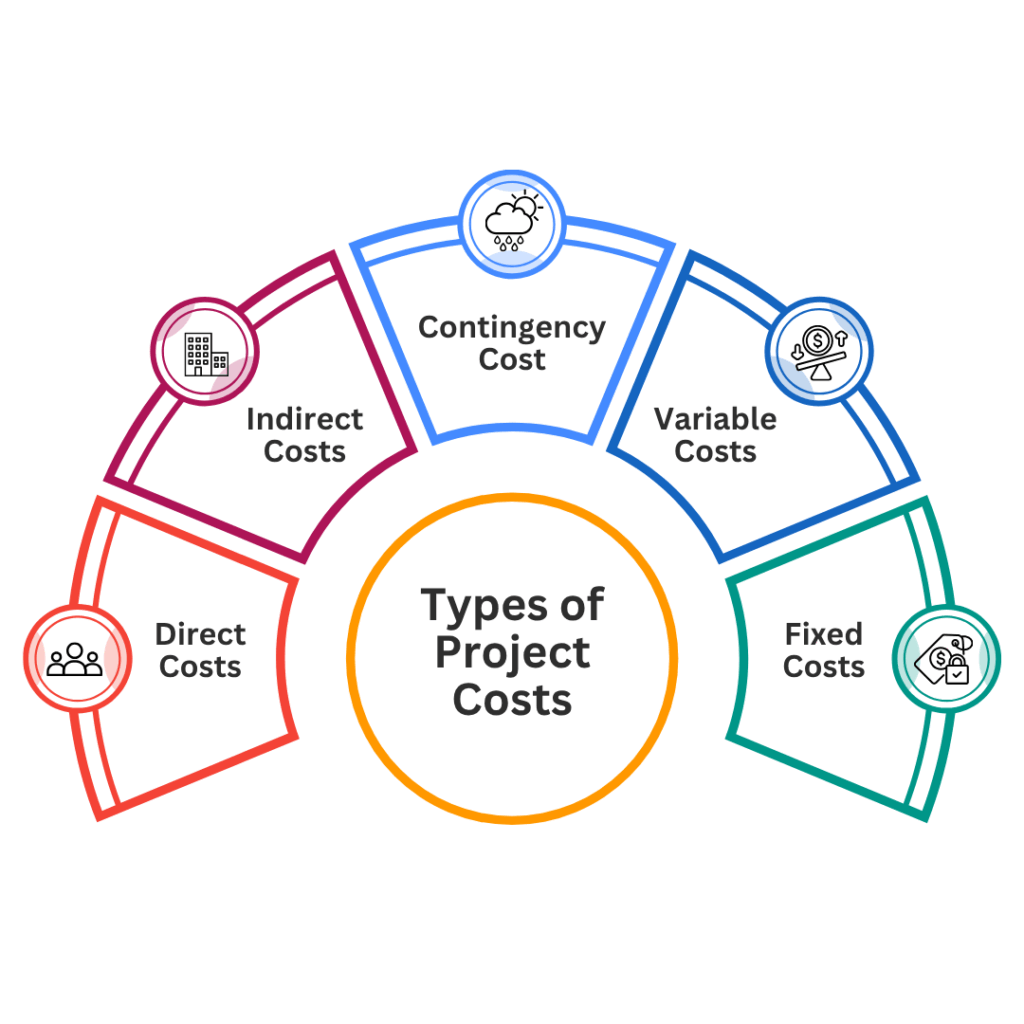Understanding project costs is fundamental to successful project delivery, and at OAE, we know that accurate cost estimation can make the difference between winning profitable contracts and facing unexpected overruns. As seasoned professionals in the estimation software industry, we recognize that effective cost management begins with accurately identifying and categorizing the various types of costs that impact your projects.
The Five Types of Project Costs
Project cost is the total amount of money required to execute a planned endeavour, a complete picture of funds you estimate, allocate, and eventually control through to project closure. It covers everything from labor and resources to overhead and past expenditures, all captured in your cost‑management framework.

Direct Cost
Direct costs are expenses that can be directly attributed to specific project activities or deliverables. These costs form the backbone of your project budget and are typically the easiest to identify and measure.
Common Examples of Direct Cost
- Labor costs for team members working directly on the project
- Raw materials and supplies used exclusively for the project
- Equipment rentals or purchases for specific project tasks
- Subcontractor fees for specialized work
- Project-specific travel expenses
- Software licenses required for project execution
Direct costs are typically variable, meaning they fluctuate in response to changes in project scope and volume. The larger your project, the more direct costs you’ll generally incur. These costs are essential for calculating the minimum viable project price and form the foundation for competitive bidding.
Indirect Costs (Overhead)
Indirect costs, also known as overhead costs, are expenses that support the overall project environment but cannot be directly traced to specific project activities. These costs are shared across multiple projects and are essential for business operations, but often overlooked in initial estimates.
Typical Example of Indirect Cost
- Office rent and utilities
- Administrative staff salaries
- General equipment and office supplies
- Insurance premiums
- Legal and accounting fees
- General management costs
- Quality assurance activities
Research indicates that construction overhead typically ranges between 10-11% of total project costs, though this can vary significantly based on project size and complexity. For large commercial projects, overhead percentages may reach 15% or higher.
Fixed Costs
Fixed costs remain constant throughout the project lifecycle, regardless of production volume or project progress. These costs provide stability in budgeting but require careful planning since they must be paid whether the project is active or not.
Examples of Fixed Costs
- Software subscriptions and licenses
- Equipment lease payments
- Insurance premiums
- Administrative salaries
- Facility rental agreements
- Permit and regulatory fees
Fixed costs are easier to forecast than variable costs, making them valuable anchors in your budget planning. However, they also represent financial commitments that continue regardless of project delays or scope changes.
Variable Costs
Variable costs fluctuate directly with the level of project activity or output. These costs increase as work progresses and decrease during slower periods, making them both responsive to project needs and challenging to predict precisely.
Common Variable Cost Includes:
- Hourly labor charges
- Materials consumed based on production volume
- Utilities tied to usage levels
- Transportation and logistics costs
- Subcontractor payments based on completed work
- Equipment usage fees
Variable costs require careful monitoring and control since they can quickly escalate if not properly managed. Understanding the relationship between project volume and variable costs helps create more accurate forecasts and identify potential cost-saving opportunities.
Contingency Costs
Contingency costs represent financial reserves set aside to address unforeseen events and risks that may arise during project execution. These costs act as a safety net, ensuring project continuity even when unexpected challenges occur.
Contingency Planning should account for:
- Design changes and scope modifications
- Market fluctuations in material costs
- Weather-related delays
- Equipment failures or breakdowns
- Regulatory changes
- Supply chain disruptions
- Unknown site conditions
Industry best practices suggest allocating 5-20% of the total project budget for contingencies, depending on project complexity and risk assessment. Rather than using a simple percentage approach, leading project managers now favor risk-based contingency planning that evaluates specific threats and their potential financial impact.
How Project Scope Can Help Define Project Costs
Establishing a comprehensive project scope is perhaps the most crucial step in accurate cost estimation. A well-defined scope serves as the foundation for identifying all cost categories and ensures nothing is overlooked in your estimates
Best Practices in Creating a Project Scope
- Comprehensive Task Lists: A detailed work breakdown structure (WBS) helps identify every task and subtask involved in the project, allowing you to assign costs to each element systematically. This granular approach prevents overlooked expenses that can derail budgets later.
- Resource Planning Alignment: Clear scope definition enables accurate resource planning by specifying exactly what materials, equipment, and personnel are needed for each project phase. This alignment between scope and resources is essential for realistic cost projections.
- Risk Assessment Framework: A well-defined scope provides the context needed for thorough risk assessment, helping identify potential cost drivers and areas where contingencies should be allocated. Understanding project boundaries makes it easier to spot where things might go wrong.
- Stakeholder Alignment: When all stakeholders agree on project scope, cost estimates become more reliable because everyone understands what is included and excluded from the project. This consensus prevents scope creep and unexpected cost additions.
How OAE Can Help Streamline Your Estimation Process
At OAE, we understand that mastering project cost estimation requires both a systematic methodology and the right tools. Our estimation software is designed to help you capture and categorize all five types of project costs while maintaining the flexibility to adapt as your projects evolve.
The integration of a comprehensive scope definition with systematic cost categorization creates a powerful foundation for accurate estimation. When you clearly understand what work needs to be done and can properly categorize the associated costs, you position your organization for sustained success in competitive markets.
By implementing these cost management principles and leveraging advanced estimation tools like OAE, you can transform your bidding process from guesswork into a strategic advantage. The result is improved win rates, better profit margins, and stronger client relationships built on accurate, reliable project delivery.

